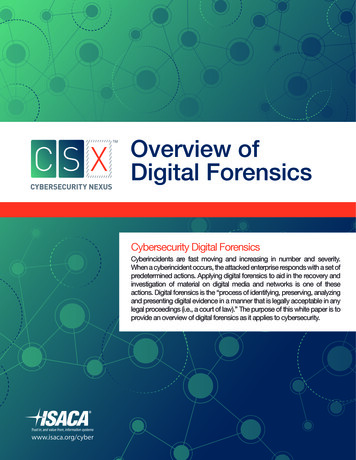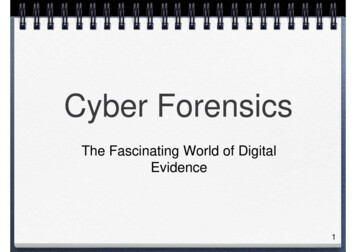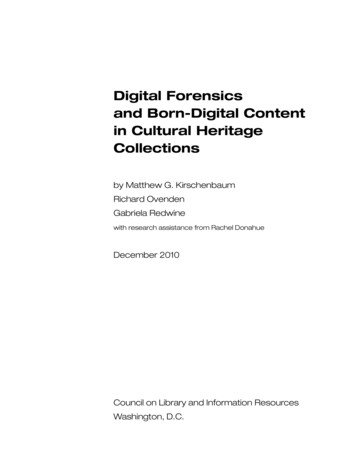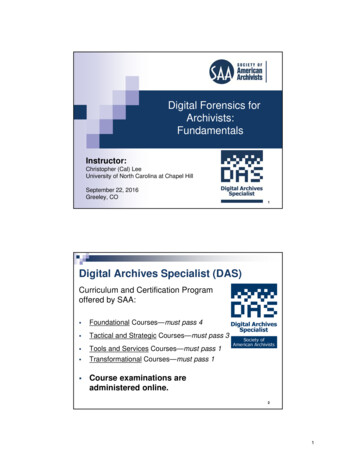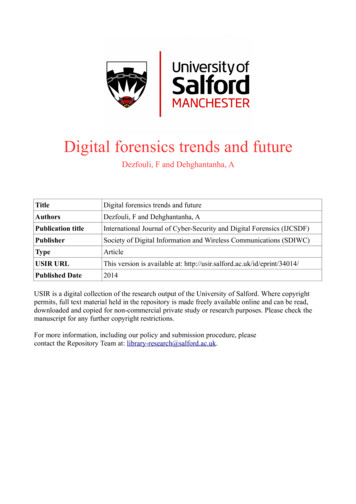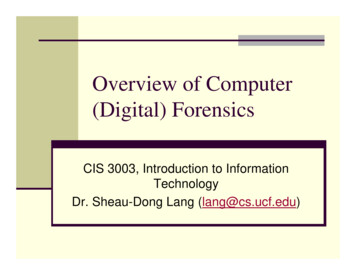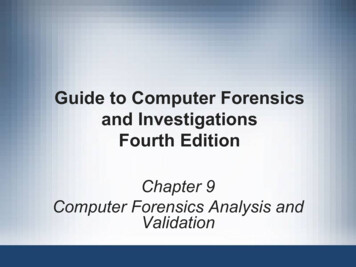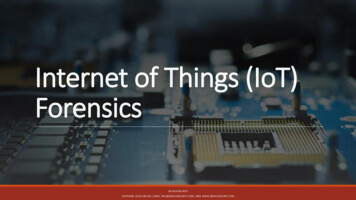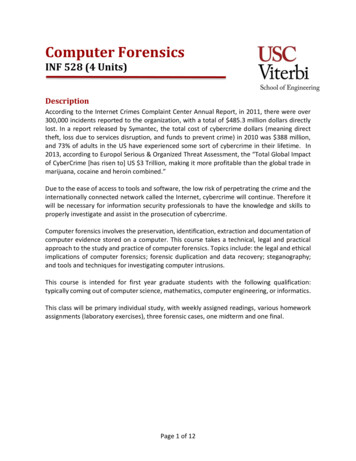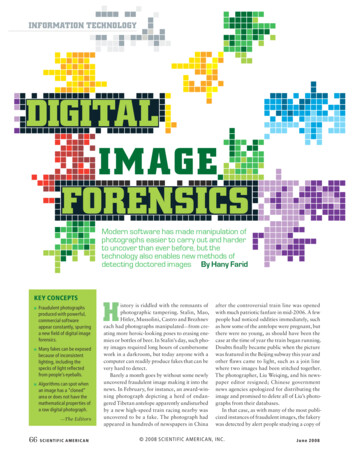
Transcription
INFORMATION TECHNOLOGYDIGITALIMAGEFORENSICSModern software has made manipulation ofphotographs easier to carry out and harderto uncover than ever before, but thetechnology also enables new methods ofdetecting doctored images By Hany FaridKEY CONCEPTSNNNFraudulent photographsproduced with powerful,commercial softwareappear constantly, spurringa new field of digital imageforensics.Many fakes can be exposedbecause of inconsistentlighting, including thespecks of light reflectedfrom people’s eyeballs.Algorithms can spot whenan image has a “cloned”area or does not have themathematical properties ofa raw digital photograph.—TheEditors66 S C I E N T I F I C A M E R I C A NHistory is riddled with the remnants ofphotographic tampering. Stalin, Mao,Hitler, Mussolini, Castro and Brezhneveach had photographs manipulated— from creating more heroic-looking poses to erasing enemies or bottles of beer. In Stalin’s day, such phony images required long hours of cumbersomework in a darkroom, but today anyone with acomputer can readily produce fakes that can bevery hard to detect.Barely a month goes by without some newlyuncovered fraudulent image making it into thenews. In February, for instance, an award-winning photograph depicting a herd of endangered Tibetan antelope apparently undisturbedby a new high-speed train racing nearby wasuncovered to be a fake. The photograph hadappeared in hundreds of newspapers in Chinaafter the controversial train line was openedwith much patriotic fanfare in mid-2006. A fewpeople had noticed oddities immediately, suchas how some of the antelope were pregnant, butthere were no young, as should have been thecase at the time of year the train began running.Doubts finally became public when the picturewas featured in the Beijing subway this year andother flaws came to light, such as a join linewhere two images had been stitched together.The photographer, Liu Weiqing, and his newspaper editor resigned; Chinese governmentnews agencies apologized for distributing theimage and promised to delete all of Liu’s photographs from their databases.In that case, as with many of the most publicized instances of fraudulent images, the fakerywas detected by alert people studying a copy of 2008 SCIENTIFIC AMERIC AN, INC.June 2008
THIS IMAGE HAS BEEN MODIFIED in several places. The digital forensic techniques described on the follow-CHRISTOPHE ENA AP Photo (bicyclists); LIU YANG Redlink Corbis (woman’s head);SHEARER IMAGES/CORBIS (fire hydrant)ing pages could be used to detect where changes were made. The answers are given on the final page.the image and seeing flaws of one kind or another. But there are many other cases when examining an image with the naked eye is not enoughto demonstrate the presence of tampering, somore technical, computer-based methods— digital image forensics— must be brought to bear.I am often asked to authenticate images formedia outlets, law-enforcement agencies, thecourts and private citizens. Each image to beanalyzed brings unique challenges and requiresdifferent approaches. For example, I used a technique for detecting inconsistencies in lighting onan image that was thought to be a composite oftwo people. When presented with an image of afish submitted to an online fishing competition,I looked for pixel artifacts that arise from resizing. Inconsistencies in an image related to itsJPEG compression, a standard digital format,w w w. S c i A m . c o mrevealed tampering in a screen shot offered asevidence in a dispute over software rights.As these examples show, because of the variety of images and forms of tampering, the forensic analysis of images benefits from having awide choice of tools. Over the past five years mystudents, colleagues and I, along with a smallbut growing number of other researchers, havedeveloped an assortment of ways to detect tampering in digital images. Our approach in creating each tool starts with understanding whatstatistical or geometric properties of an imageare disturbed by a particular kind of tampering.Then we develop a mathematical algorithm touncover those irregularities. The boxes on thecoming pages describe five such forensictechniques.The validity of an image can determine wheth- 2008 SCIENTIFIC AMERIC AN, INC.[THE AUTHOR]Hany Farid has worked with federal law-enforcement agencies andmany other clients on uncoveringdoctored images. Farid is David T.McLaughlin Distinguished Professor of Computer Science and Associate Chair of Computer Science atDartmouth College and is alsoaffiliated with the Institute forSecurity Technology Studies atDartmouth. He thanks the studentsand colleagues with whom he hasdeveloped digital forensic methods, in particular Micah K. Johnson,Eric Kee, Siwei Lyu, Alin Popescu,Weihong Wang and JeffreyWoodward.SCIENTIFIC AMERICAN67
[LIGHTING]IN A DIFFERENT LIGHTFor an image such as the one at the right, my groupcan estimate the direction of the light source for eachperson or object (arrows). Our method relies on thesimple fact that the amount of light striking a surfacedepends on the relative orientation of the surface tothe light source. A sphere, for example, is lit the moston the side facing the light and the least on the opposite side, with gradations of shading across its surfaceaccording to the angle between the surface and thedirection to the light at each point.To infer the light-sourcedirection, you must knowthe local orientation of thesurface. At most places onan object in an image, it isdifficult to determine theorientation. The one exception is along a surface contour, where the orientationis perpendicular to the contour (red arrows above).By measuring the brightness and orientation alongseveral points on a contour, our algorithm estimatesthe light-source direction.For the image above, the light-source direction for the police does not match that for the ducks(arrows). We would have to analyze other items to be sure it was the ducks that were added. — H.F.HUGHES LÉGLISE-BATAILLE (riot); CHARRO BADGER InTheSunStudio (ducks); LISA APFELBACHER (illustration)Composite images made of pieces from different photographs can display subtle differences in the lighting conditions under which each personor object was originally photographed. Such discrepancies will often go unnoticed by the naked eye.[SHAPES]EYES AND POSITIONBecause eyes have very consistent shapes, they can be useful for assessing whether a photograph has been altered.A person’s irises are circular in reality but will appear increasingly elliptical as the eyes turn to the side or up or down (a).One can approximate how eyes will look in a photograph bytracing rays of light running from them to a point called thecamera center (b). The picture forms where the rays cross theimage plane (blue). The principal point of the camera — theintersection of the image plane and the ray along which thecamera is pointed — will be near the photograph’s center.WorldAuthenticcPerson’s irisesInferredprincipal pointaDoctoreddbPrincipal pointIris68 S C I E N T I F I C A M E R I C A NCamera centerMy group uses the shape of a person’s two irises in the photograph to infer how his or hereyes are oriented relative to the camera and thus where the camera’s principal point is located (c). A principal point far from the center or people having inconsistent principal points isevidence of tampering (d). The algorithm also works with other objects if their shapes areknown, as with two wheels on a car.The technique is limited, however, because the analysis relies on accurately measuring theslightly different shapes of a person’s two irises. My collaborators and I have found we can reliably estimate large camera differences, such as when a person is moved from one side of theimage to the middle. It is harder to tell if the person was moved much less than that.— H.F. 2008 SCIENTIFIC AMERIC AN, INC.June 2008COURTESY OF HANY FARID (a); LISA APFELBACHER (b–d)Photograph
er or not someone goes to prison and whether aclaimed scientific discovery is a revolutionaryadvance or a craven deception that will leave adark stain on the entire field. Fake images cansway elections, as is thought to have happenedwith the electoral defeat of Senator Millard E.Tydings in 1950, after a doctored picture wasreleased showing him talking with Earl Browder,the leader of the American Communist Party.Political ads in recent years have seen a startlingnumber of doctored photographs, such as a fauxnewspaper clipping distributed on the Internet inearly 2004 that purported to show John Kerryon stage with Jane Fonda at a 1970s VietnamWar protest. More than ever before, it is important to know when seeing can be believing.[SPECULAR HIGHLIGHTS]TELLTALE TWINKLESSurrounding lights reflect in eyes to form small white dots called specular highlights.The shape, color and location of these highlights tell us quite a bit about the lighting.FOX NEWS (American Idol); LISA APFELBACHER (eyes); MELISSA THOMAS (specular highlights)Everywhere You LookThe issue of faked images crops up in a widevariety of contexts. Liu was far from the firstnews photographer to lose his job and have hiswork stricken from databases because of digitalfakery. Lebanese freelancer Adnan Hajj produced striking photographs from Middle Eastern conflicts for the Reuters news agency for adecade, but in August 2006 Reuters released apicture of his that had obviously been doctored.It showed Beirut after being bombed by Israel,and some of the voluminous clouds of smokewere clearly added copies.Brian Walski was fired by the Los AngelesTimes in 2003 after a photograph of his fromIraq that had appeared on the newspaper’s frontpage was revealed to be a composite of elementsfrom two separate photographs combined forgreater dramatic effect. A sharp-eyed staffer atanother newspaper noticed duplicated people inthe image while studying it to see if it showedfriends who lived in Iraq. Doctored covers fromnewsmagazines Time (an altered mug shot ofO. J. Simpson in 1994) and Newsweek (MarthaStewart’s head on a slimmer woman’s body in2005) have similarly generated controversy andcondemnation.Scandals involving images have also rockedthe scientific community. The infamous stemcell research paper published in the journal Science in 2005 by Woo Suk Hwang of SeoulNational University and his colleagues reportedon 11 stem cell colonies that the team claimed tohave made. An independent inquiry into thecase concluded that nine of those were fakes,involving doctored images of two authentic colonies. Mike Rossner estimates that when he wasthe managing editor of the Journal of Cell Biolw w w. S c i A m . c o mIn 2006 a photo editor contacted me about a picture of American Idol stars that was scheduledfor publication in his magazine (above). The specular highlights were quite different (insets).ScleraSpecularhighlightCorneaCenters of spheresThe highlight position indicates where the light source is located (above left). As the direction tothe light source ( yellow arrow) moves from left to right, so do the specular highlights.The highlights in the American Idol picture are so inconsistent that visual inspection is enough toinfer the photograph has been doctored. Many cases, however, require a mathematical analysis.To determine light position precisely requires taking into account the shape of the eye and the relative orientation between the eye, camera and light. The orientation matters because eyes are notperfect spheres: the clear covering of the iris, or cornea, protrudes, which we model in software asa sphere whose center is offset from the center of the whites of the eye, or sclera (above right).Our algorithm calculates the orientation of a person’s eyes from the shape of the irises in theimage. With this information and the position of the specular highlights, the program estimatesthe direction to the light. The image of the American Idol cast (above; directions depicted by reddots on green spheres) was very likely composed from at least three photographs.— H.F. 2008 SCIENTIFIC AMERIC AN, INC.SCIENTIFIC AMERICAN69
[DUPLICATION]SEND IN THE CLONESThis image is taken from a television ad used byGeorge W. Bush’s reelection campaign late in 2004. Finding cloned regionsby a brute-force computer search, pixel by pixel, of all possible duplicatedregions is impractical because they could be of any shape and located anywhere in the image. The number of comparisons to be made is astronomical,and innumerable tiny regions will be identical just by chance (“false positives”). My group has developed a more efficient technique that works withsmall blocks of pixels, typically about a six-by-six-pixel square (inset).For every six-by-six block of pixels in the image, the algorithm computes aquantity that characterizes the colors of the 36 pixels in the block. It then usesthat quantity to order all the blocks in a sequence that has identical and verysimilar blocks close together. Finally, the program looks for the identical blocksand tries to “grow” larger identical regions from them block by block. By dealing in blocks, the algorithm greatly reduces the number of false positives thatmust be examined and discarded.When the algorithm is applied to the image from the political ad, itdetects three identical regions (red, blue and green).— H.F.COURTESY OF HANY FARIDCloning — the copying and pasting of a region of an image — is a very common and powerful form of manipulation.[RETOUCHING]CAMERA FINGERPRINTSDigital retouching rarely leaves behind a visual trace. Because retouching can take many forms, I wanted to develop an algorithm that woulddetect any modification of an image. The technique my group came up with depends on a feature of how virtually all digital cameras work.38424032(38 42) / 2 40(38 40) / 2 39(38 42 40) / 4 38etc38 40 4239 38 3740 36 32camera allegedly used to take the picture, the image has been retouched insome fashion.My group’s algorithm looks for these periodic correlations in a digitalimage and can detect deviations from them. If the correlations are absent in asmall region, most likely some spot changes have been made there. The correlations may be completely absent if image-wide changes were made, such asresizing or heavy JPEG compression. This technique can detect changes suchas those made by Reuters to an image it released from a meeting of the UnitedNations Security Council in 2005 (left): the contrast of the notepad wasadjusted to improve its readability.A drawback of the technique is that it can be applied usefully only to anallegedly original digital image; a scan of a printout, for instance, would havenew correlations imposed courtesy of the scanner.— H.F.70 S C I E N T I F I C A M E R I C A N 2008 SCIENTIFIC AMERIC AN, INC.June 2008RICK WILKING Reuters (note); LISA APFELBACHER (grids)A camera’s digital sensors are laid out in a rectangular grid of pixels, but eachpixel detects the intensity of light only in a band of wavelengths near one color, thanks to a color filter array (CFA) that sits on top of the digital sensorgrid. The CFA used most often, the Bayer array, has red, green and blue filters arranged as shown at the right.Each pixel in the raw data thus has only one color channel of the threerequired to specify a pixel of a standard digital image. The missing dataare filled in — either by a processor in the camera itself or by software thatinterprets raw data from the camera — by interpolating from the nearbypixels, a procedure called demosaicing. The simplest approach is to takethe average of neighboring values, but more sophisticated algorithms arealso used to achieve better results. Whatever demosaicing algorithm isapplied, the pixels in the final digital image will be correlated with theirneighbors. If an image does not have the proper pixel correlations for the
ogy, as many as a fifth of the accepted manuscripts contained a figure that had to be remadebecause of inappropriate image manipulation.The authenticity of images can have myriadlegal implications, including cases involvingalleged child pornography. In 2002 the U.S.Supreme Court ruled that computer-generatedimages depicting a fictitious minor are constitutionally protected, overturning parts of a 1996law that had extended federal laws against childpornography to include such images. In a trialin Wapakoneta, Ohio, in 2006, the defenseargued that if the state could not prove thatimages seized from the defendant’s computerwere real, then he was within his rights in possessing the images. I testified on behalf of theprosecutor in that case, educating the jurorsabout the power and limits of modern-dayimage-processing technology and introducingresults from an analysis of the images usingtechniques to discriminate computer-generatedimages from real photographs. The defense’sargument that the images were not real wasunsuccessful.Yet several state and federal rulings havefound that because computer-generated imagesare so sophisticated, juries should not be askedto determine which ones are real or virtual. Atleast one federal judge questioned the ability ofeven expert witnesses to make this determination. How then are we to ever trust digital photography when it is introduced as evidence in acourt of law?Arms RaceThe methods of spotting fake images discussedin the boxes have the potential to restore somelevel of trust in photographs. But there is littledoubt that as we continue to develop software toexpose photographic frauds, forgers will workon finding ways to fool each algorithm and willhave at their disposal ever more sophisticatedimage manipulation software produced for legitimate purposes. And although some of the forensic tools may be not so tough to fool — forinstance, it would be easy to write a program torestore the proper pixel correlations expected ina raw image— others will be much harder to circumvent and will be well beyond the averageuser. The techniques described in the first threeboxes exploit complex and subtle lighting andgeometric properties of the image formationprocess that are challenging to correct usingstandard photo-editing software.As with the spam/antispam and virus/antiviw w w. S c i A m . c o m3L3L1L2L2L2LOPENER ANSWER: Inconsistent specular highlights(bottom) indicate the two leading cyclists werenot photographed together. The light-sourcedirection (arrows) for the girl’s face conflicts withthat of “her” body and the other cyclists. Theadded fire hydrant has yet another light-sourcedirection. Cloned shrubs, grass and the curbside L1cover cyclists in the background. Spoiled pixelcorrelations might reveal areas where retouchingremoved logos L2 and that the girl’s helmet isdoctored L3 ; it is copied from the man’s but alsohas been recolored. The original photograph canbe seen at www.SciAm.com/jun2008rus game, not to mention criminal activity ingeneral, an arms race between the perpetratorand the forensic analyst is inevitable. The fieldof image forensics will, however, continue tomake it harder and more time-consuming (butnever impossible) to create a forgery that cannotbe detected.Although the field of digital image forensicsis still relatively young, scientific publishers,news outlets and the courts have begun toembrace the use of forensics to authenticate digital media. I expect that as the field progressesover the next five to 10 years, the application ofimage forensics will become as routine as theapplication of physical forensic analysis. It is myhope that this new technology, along with sensible policies and laws, will help us deal with thechallenges of this exciting— yet sometimes baffling— digital age.N 2008 SCIENTIFIC AMERIC AN, INC.2L MORE TOEXPLOREExposing Digital Forgeries inColor Filter Array InterpolatedImages. Alin C. Popescu and HanyFarid in IEEE Transactions on SignalProcessing, Vol. 53, No. 10, pages3948–3959; October 2005. Availableat Detecting Photographic Composites of People. Micah K. Johnsonand Hany Farid. Presented at the6th International Workshop onDigital Watermarking, Guangzhou,China, 2007. Available tmlLighting and Optical Tools forImage Forensics. Micah K. Johnson.Ph.D. dissertation, Dartmouth College, September 21, 2007. Availableat 7.htmlHany Farid’s Web site:www.cs.dartmouth.edu/faridSCIENTIFIC AMERICAN71
a new field of digital image forensics. NMany fakes can be exposed because of inconsistent lighting, including the specks of light reflected from people’s eyeballs. NAlgorithms can spot when an image has a “cloned” area or does not have the mathematical properties of a raw digital ph
